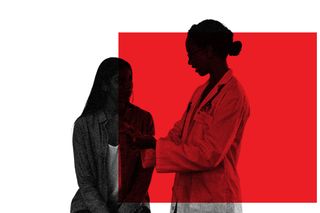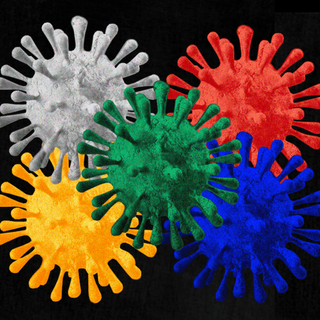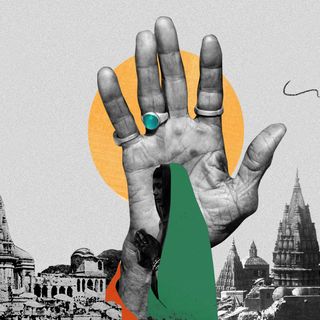
For Endometriosis Patients, Better Communication Could Lead to Faster Diagnosis
New research found that women use metaphors to describe pain as an attempt to communicate it with accuracy, but it’s often dismissed during consultations.

“It took me 17 years to get a diagnosis for endometriosis. My symptoms began when I was around 10 years old, and I kept going from one doctor to another throughout my late childhood and teenage years,” is how one patient with endometriosis described her experience to The Swaddle. 17 years is a punishingly long time to wait for a diagnosis of a life-altering condition — indeed, the person described how having a diagnosis helped her manage, treat, and talk about endometriosis.
Sometimes, a diagnosis is a holy grail that doesn’t come by nearly often or fast enough. Endometriosis is one of the many gendered health conditions characterized by pain that isn’t taken seriously, leading to debilitating consequences. New research has shown how communication is a key factor in diagnosing endometriosis, and that improving the way we talk about pain could help by leaps and bounds.
Published this month in Frontiers in Global Women’s Health, the study explored “what patients and doctors consider challenging and effective in endometriosis pain communication.” The UK-based research included 131 participants who live with endometriosis and 11 general physicians. Results showed that for both patients and doctors, describing the “quality, location, and impact on daily life of pain” was a more effective strategy.
For example, doctors in the study suggested pointing to the location on an anatomical diagram, speaking openly about pain during sex or bowel movements, and qualitative descriptions (“whether it’s a cramping type pain, an aching type pain, a stabbing type pain”) helps them understand patients’ pain better.
Unhelpful communication practices, on the other hand, included the Numeric Rating Scale (NRS) in which pain is “rated” on a scale of 1-10. Previous research has also shown that women’s self-reported pain on this scale tends to be undermined, due to a sexist perception of women exaggerating their pain or having a lower pain threshold.
Further, the study found some women more likely to use metaphors or similes to describe endometriosis pain, such as “as if somebody is repeatedly stabbing me with a large knife,” or “like having a hot poker planted inside your stomach” — as an attempt to effectively articulate the pain. But these descriptors were likely to be misinterpreted by doctors, who may associate their pain with nerve issues or infection. In other words, such language doesn’t immediately convey endometriosis to practitioners, who are then likely to test for other conditions, which in turn delays diagnosis.
The findings speak to a lacuna in medicine, where gendered pain is invisibilized and scarcely understood. “The communication challenges posed by the lack of visibility, physical manifestations, and experiential understanding of invisible pain, as is the case with endometriosis, leads patients to rely on metaphorical language,” the paper stated.
The present study emphasizes the need for communication tools that can effectively translate endometriosis pain into a faster diagnosis. But its significance also lies in the fact that it highlights how medical practitioners are trained to understand pain only if communicated in a much narrower way than what patients really experience.
Related on The Swaddle:
Women With Endometriosis Turning to Alternative Therapies for Relief
The use of metaphors and similes is a promising approach to having conversations about the actual experience of pain and closing some of the distance between patients and doctors — despite the current gap. They can help articulate the experience of pain in more qualitative terms — something that researchers and doctors agree would help.
Patients in the current study benefitted from “linguistic and visual tools” to accurately capture their pain. “I did not associate what I was feeling as ‘pain.’ I needed to see a list of feelings … like burning, dragging, squeezing,” said one participant in the study.
The study also notes that due to the interrelated factors of physical stress, psychological distress, and others, pain sensitivity is often heightened in people with endometriosis. This means that the NRS is not sufficient, and more qualitative tools are required to understand how endometriosis interferes “with physical and emotional aspects of quality of life.”
While such diagnostic tools exist, they are usually employed during the treatment stage. The current research advocates for using these tools for diagnosis as well.
The key takeaways from the research are in terms of facilitating better patient-doctor conversations. ” [L]et patients talk about how the pain keeps them from living their everyday lives, such as it hurts when I have sex, exercise, go up stairs, stand for too long, etc. Also, give keywords and/or examples to describe the pain.” These may include phrases like “it feels like someone is stabbing me” or “it feels like I’m having contractions before giving birth.” Moreover, more attention needs to be paid to patients’ requests for doctors to listen to them and ask more specific questions.
At the heart of the matter is how we talk about pain, especially when it comes to conditions that don’t affect cisgender men. “I find docs intimidating and sometimes lose my words because they are very abrasive and harsh regarding pain,” said one participant in the study, speaking to the experience of what it feels like when there is no space — literally and figuratively — for women’s pain in society.
Previous research also showed that the effects of not receiving a diagnosis due to pain dismissal can compound the feeling of disempowerment that comes with endometriosis. Menstruation stigma and “menstrual etiquette” — or the “strategic concealment of menstrual problems” — can further prevent effective disclosure of symptoms, according to one study.
“Stop acting like the pain I’m in is normal. It’s not normal to be stuck in bed for three days,” said another participant, whose experience cuts to the core of how much pain is normalized in a medical setting, and why this needs to change now.
Rohitha Naraharisetty is a Senior Associate Editor at The Swaddle. She writes about the intersection of gender, caste, social movements, and pop culture. She can be found on Instagram at @rohitha_97 or on Twitter at @romimacaronii.
Related


What We Know About the New Covid Variant With ‘Horrific’ Mutations
